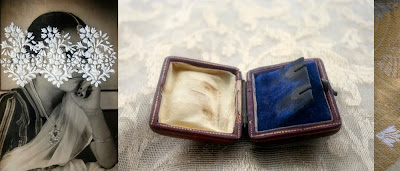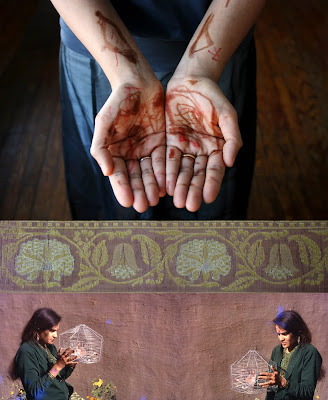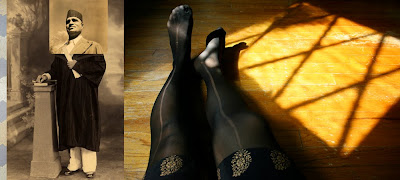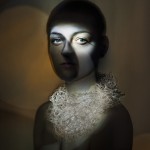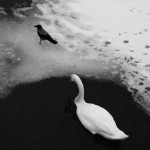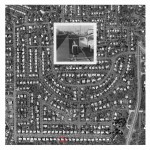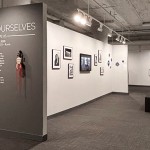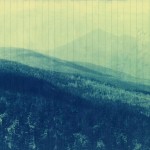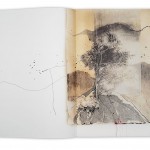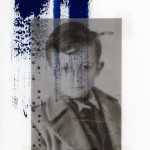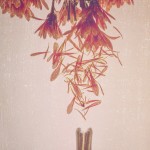Success Stories: Priya Kambli
Looking at participants from Photolucida…
“Photography has been a way of bridging the gap between…two cultures while coming to terms with my dual nature.” —Priya Kambli
I have been an admirer of Priya Kambli’s images and approach to photography, and was thrilled when her work was celebrated with a Critical Mass Book Award in 2008. It was a treat to get to meet her in Portland, where she was juggling intense portfolio reviews with a family and new baby waiting for her back in her hotel room.
Priya was born and raised in India and moved to the United States at the age of 18, carrying her entire life in one suitcase weighing about 20 lbs. “I began my artistic career in the States, and my work has always been informed by my experience as a migrant. I completed my Bachelor of Fine Arts degree at the University of Louisiana in Lafayette and continued on to receive a Masters degree in Photography from the University of Houston. I am currently an Associate Professor of Art at Truman State University in Kirksville, Missouri – a community where I have lived longer than anywhere else. It’s here in Kirksville that I met my husband and had our beautiful son, Kavi, with whom I can finally share the language that I grew up speaking. “
Priya series and book, Color Falls Down, is a wonderful visual stew (or curry) of her past and present, combined to make a feast of culture, memory, and identity.
Color Falls Down
My photographs visually express the notion of transience and split cultural identity caused by the act of migration. I have been viewing this issue through the lens of my own personal history and cultural journey from India to the United States. This journey left me feeling disconnected- unable to anchor myself in any particular cultural framework. I have therefore formed a hybrid identity, a patching together of two cultures within one person.In my work I explore absence, loss and genealogy through the use of my own family snapshots. These personal artifacts are recontextualized alongside fragmented images and staged imagery to reveal the correlations between generations, cultures and memory.
Q. It was so great to finally meet you at Photolucida, as I’ve been a long time fan. I was blown away by the fact you were attending a very stressful review with a husband, baby, and toddler back in your hotel room. How do you juggle it all?
A. It was lovely to meet you at the PhotoLucida reviews. I am a big fan of your blog and I am excited that you decided to interview me.
I think I plow through rather than juggle. It definitely helps to have a supportive husband who is willing to travel with me and babysit our kids while I do the reviews.
Plus, it’s very important for me to get my current body of work out and give it a fulfilling life that I think it deserves. Combine that with the fact that I live in a small rural town in the middle of nowhere – and this means these reviews are the most convenient vehicle for disseminating that work available to me. In that regard I feel like I really don’t have a choice but to attend the reviews.

Q. I love that you grew up in India, but are living now in Kirksville, Missouri. I would imagine that there is not much Indian culture in Kirksville and am wondering if your work reflects a desire to be connected to your roots? Where do you feel at home?
A. There isn’t any Indian community in Kirksville; in fact there is a shocking lack of color in the community in general. I remember going to a conference in Detroit after having lived in Kirksville for about a semester and realizing that I was brazenly staring at people of different ethnicities and realized how deprived my eyes and life were of color and diversity. But oddly enough I have made peace with being in Kirksville and I have accentuated its diversity by adding two more brown people to its population (my two kids) – and to me home is wherever they are.
I don’t think of my work as reconnecting with India per se, but I am definitely thinking of my family. This body of work is rooted in my fascination with my parents – both of whom died when I was young. Therefore for me these family photographs hold even more mythological weight; I still see my parents through the eyes of a child – who can’t comprehend that their parents aren’t giants, but merely individuals of ordinary height.
Q. You are such a natural storyteller, and your incredible graphic sensibility adds a sophisticated and meaningful layer to your work. Can you talk about how you create the compositions.
A. Thank you. My graphic sensibility might be due to the fact that my background includes a BFA in Graphic design. For most of the constructed images the family photograph is usually the jumping off point -the intent is usually embedded in that photograph itself- that little detail dictates the other set of images I create to juxtapose with the family photograph. In the end I hope that I’ve made something more universally accessible out of that personal photograph.
My creative process for producing artwork is akin to fitting together the many pieces of a puzzle. A single digitally created photograph is made up of several discrete sections that are arranged in a carefully balanced composition. Each section affects the others and expresses a different aspect of the narration. Some of the sections are my own creation other sections contain family photos which are sometimes manipulated further.
Q. Because your work is presented an a unique way, have you come up against any difficulties in getting it into the traditional photography world?
A. I haven’t faced any difficulties so far- at least not that I am aware of! People are very curious about my work and are for the most part receptive. Naturally I am aware that there are these different genres in the photo world and not everyone is interested in the kind of work I am doing – and I’m aware that I’m not a perfect fit in certain ‘scenes’. But I definitely feel there is ample space for what I do.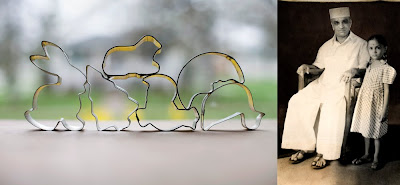
Q. Did being selected as a Critical Mass Book recipient bring you more attention and opportunities?
A. It definitely validated the work and made it accessible to a large audience instantly. It didn’t necessarily mean that people got the book and called me up out of the blue for a show – but once the book was out people I made connections with were often already aware of my work and perhaps more likely to provide me with a new outlet for my work. It’s as if I’ve already been introduced to people when we’ve really just met for the first time.
Q. What would you say was the one thing that helped get your foot in the door, and took your exposure to the next level?
A. The portfolio reviews have been very helpful for me, last year I participated in FotoFest, which brought a lot of interesting opportunities my way. I participated in PhotoLucida’s Reviews this year and I think that this will lead to even more opportunities. So it’s these big photo world events that have been very helpful for me.
Q. Are you involved in social networking outlets? Do you tweet or are you active on Facebook?
A. I don’t tweet, but I definitely am a faithful Facebook follower. I use Facebook as much as a way to stay in touch with people in the field as with other family and friends. It really helps to overcome the fact that geographically I am isolated from the photo world.
Q. What advice can you give emerging photographers, especially on presentation, on networking, on consistently producing excellent work?
A. I know that what has worked for me is being very focused, consistent in producing new work, and very professional about following up on the relationships I’ve made in the photo community.
Q. Do you ever have periods of self doubt and feel creatively unmotivated? How do you manage it with young children and a teaching position?
A. I constantly doubt myself. I always panic once an image is completed- wondering if I can create another one. I think the self-doubt keeps me on my toes and motivated but I have to admit it is rather taxing.
I am very focused about my artwork. Making art is a ritual that is ingrained in my everyday life. It is part of my identity and frankly I could have an identity crises if I didn’t make art. I don’t always balance things perfectly – and certain things sometimes suffer but ultimately I make sure I always have goals that I am working towards.
Q.Is there an artist or photographer that has influenced you or your work?
A. Yes, tons- there is a lot of magnificent work being produced and I am constantly trolling the web for new inspirations. I do really focus more on looking at contemporary art and my list of artists that inspire and influence me is lengthy but I will jot down a few names of artists whose work I can’t get enough off: Peggy Nolan, Carolle Benitah, Toni Greaves, Doug Dubois, Susan Worsham, Elijah Gowin and Ian Van Coller.
Q. And finally, what would be your perfect day?
A. Frankly, I have no idea, but I think it would involve a chocolate éclair.
Posts on Lenscratch may not be reproduced without the permission of the Lenscratch staff and the photographer.
Recommended
-
Ragne Kristine Sigmond: Portraits of Painterly LightDecember 2nd, 2025
-
Mary Pat Reeve: Illuminating the NightDecember 1st, 2025
-
Ricardo Miguel Hernández: When the memory turns to dust and Beyond PainNovember 28th, 2025
-
Pamela Landau Connolly: Columbus DriveNovember 26th, 2025
-
MATERNAL LEGACIES: OUR MOTHERS OURSELVES EXHIBITIONNovember 20th, 2025

